How to Make Steel Wool and Vinegar Stain
This steel wool and vinegar stain is easy to make, easy to apply, and instantly gives wood a deep, rich color. Make some now with this goof-proof recipe!
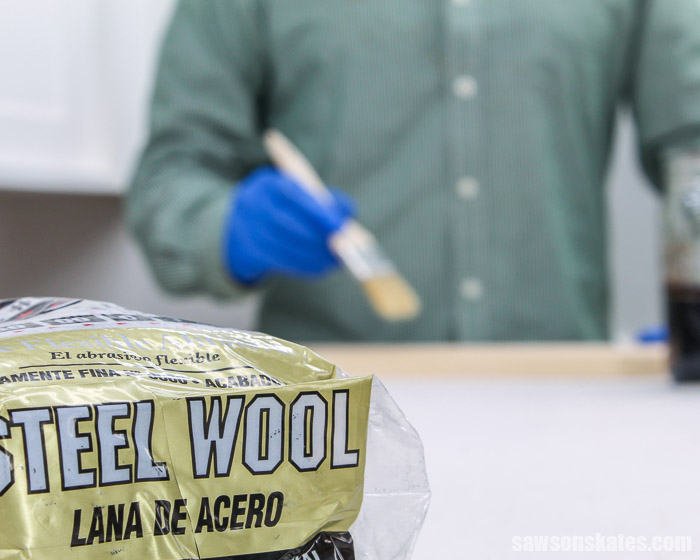
Steel Wool and Vinegar Stain
This DIY stain is made with two simple ingredients. Steel wool and vinegar. Steel wool and vinegar stain is a great alternative to store-bought wood stains. It’s easy to make and easy to apply. We’ll test four types of vinegar combined with three kinds of homemade pre-stain conditioners to instantly create a variety of deep, rich colors.
This tutorial contains affiliate links to supplies and tools. Purchases made using these links help support the Saws on Skates website and allows me to share more projects and tips with you. There is no cost to you for using these links. Visit my site policies for more information.
Before we get into how to make steel wool and vinegar stain, be sure to click the subscribe button at the bottom of this page to sign up for my FREE weekly newsletter loaded with helpful pocket hole tricks, space-saving workshop ideas, clever DIY tips and more!
Table of Contents
- Inspiration for This Project
- What Happens When You Mix Vinegar and Steel Wool?
- What Happens When You Apply a Steel Wool and Vinegar Stain to Wood?
- Experiment Results
- What Do You Need to Make a Steel Wool and Vinegar Stain?
- How Long Should Steel Wool Sit in Vinegar?
- What If I Don’t See a Reaction?
- What is the Shelf Life?
- What Kind of Wood Can You Stain?
- How Do You Apply the Stain?
- How Many Coats of Stain Can You Apply?
- Do You Need to Sand Between Coats?
- How Do You Prepare the Wood?
- How Do You Seal the Wood?
- How Long Should You Wait Before Sealing?
- How to Make Steel Wool and Vinegar Stain Tutorial
Inspiration for This Project
A while back, I shared this dark brown stain tutorial. In that tutorial, I mentioned that I applied a steel wool and vinegar stain to this DIY electric fireplace.
After publishing that tutorial, I received messages from readers asking for a more in-depth look at how I made a stain with steel wool and vinegar.
I used white vinegar in that tutorial, so I thought we should try something different this time. In this tutorial, I tried mixing steel wool with:
- White Vinegar
- Red Wine Vinegar
- Apple Cider Vinegar
- Balsamic Vinegar
In the dark brown stain tutorial, I applied a DIY wood conditioner before I applied the vinegar steel wool stain. The DIY wood conditioner that I used was black tea. Yes, the black tea that you drink.
Related: How to Make a Tea Stain
In this tutorial, I experimented with applying three homemade pre-stain conditioners before applying the steel wool stain:
- Tea
- Coffee
- DIY Black Walnut Stain
Related: What I Use Instead of Wood Conditioner
Back to Table of ContentsWhat Happens When You Mix Vinegar and Steel Wool?
Mixing vinegar and steel wool creates a chemical reaction. The vinegar causes the steel wool to rust or oxidize.
⚠️ IMPORTANT: Do not cover the container. The chemical reaction causes the steel wool and vinegar mixture to off-gas. This gas must be able to escape from the container. Allow the mixture to sit uncovered either outdoors or in a well-ventilated area.
What Happens When you Apply a Steel Wool and Vinegar Stain to Wood?
Applying a steel wool and vinegar stain to wood causes the wood to instantly change color. This color change is different from the color change that happens when we apply a store-bought wood stain.
Applying a store-bought stain adds color to the wood. It’s similar to applying a coat of paint to a wall.
Applying a vinegar steel wool stain causes a chemical reaction with the wood. The stain reacts with the wood and causes it to oxidize.
It’s a similar reaction that happened to make the vinegar steel wool stain. The vinegar caused the metal of the steel wool to oxidize or rust.
Related: How to Age Metal
It’s important to note that the chemical reaction between the stain and wood can be slightly unpredictable. In other words, the color might vary slightly from board to board.
Back to Table of Contents
Experiment Results
I expected to see a big color difference between the four types of vinegar, but the most dramatic color differences were between the pre-stain conditioners.
I planned to share photos of all the samples, but the white, apple cider, and red wine looked nearly identical. It actually looked like I posted the same photo three times!
The biggest difference was between the balsamic vinegar and the other three kinds of vinegar.
Instead of sharing all four vinegar samples, I decided it made the most sense to share the ones with the most dramatic differences: the white and balsamic.
White Vinegar
The white, apple cider, and red wine vinegar all had a warm, reddish undertone.
The “vinegar” sample was applied directly to bare wood. No pre-stain conditioner was used for this sample.
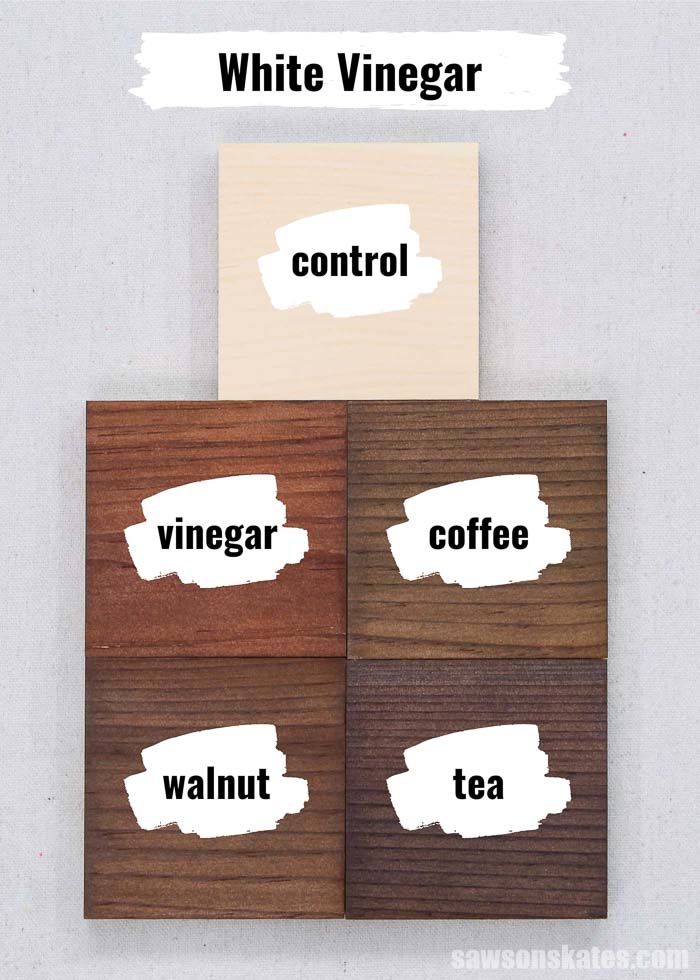
Balsamic Vinegar
The balsamic samples had a cool, greenish undertone.
The “vinegar” sample was applied directly to bare wood. No pre-stain conditioner was used for this sample.
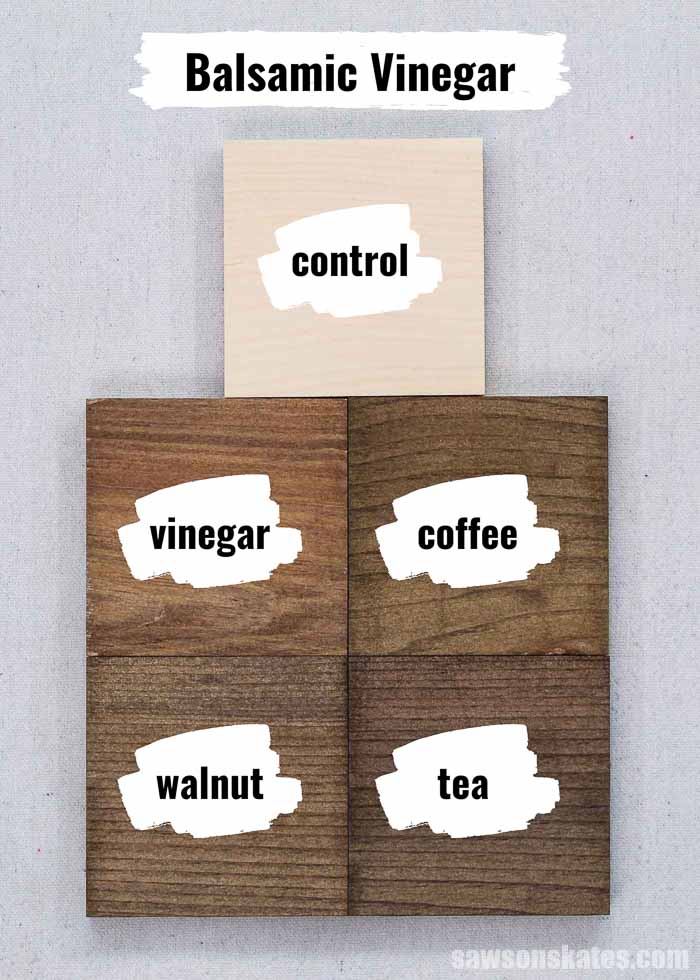
What Do You Need to Make Steel Wool and Vinegar Stain?
We only need a few simple ingredients to make a vinegar steel wool stain.
We’ll need some steel wool. I used #0000 steel wool to make my stain.
We’ll need some vinegar. I used white vinegar, apple cider vinegar, red wine vinegar, and balsamic vinegar that I purchased at my local grocery store.
We’ll also need a container to mix the vinegar and steel wool. I used a 1-quart mason jar to mix mine.
After the mixture sat for a few days, I strained it using one of the techniques that I use to strain paint.
Related: How to Strain Paint
Back to Table of ContentsHow Long Should Steel Wool Sit in Vinegar?
I’ve heard the longer the mixture sits, the darker the stain will get. I usually let my stain sit for about three to four days. You could try a shorter time, like 24 hours to see if you get a different result.
Back to Table of ContentsWhat If I Don’t See a Reaction?
You may not see a reaction. I let my stain sit for about three to four days.
After four days there was only a slight color change in the white vinegar. It changed from clear to slightly greenish/blue color.
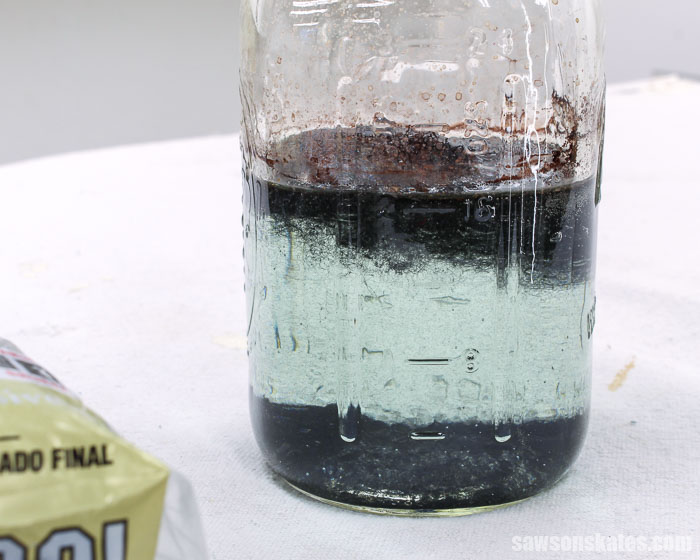
Then, I removed the steel wool and strained the solution. After straining, I noticed the solution had become very dark.
Back to Table of ContentsWhat is the Shelf Life?
I don’t know the exact shelf life of the stain, but it appears to become less effective over time.
On the left, is a raw piece of wood without any stain. On the right, is a piece of wood that was stained with the vinegar stain that I made for this tutorial.
In the middle, is a piece of wood that I stained for this tutorial using a vinegar stain that I made several years ago. The stain that I made several years ago was not as dark as the fresh stain.
My recommendation would be to make the stain and use it as soon as possible for the deepest color.
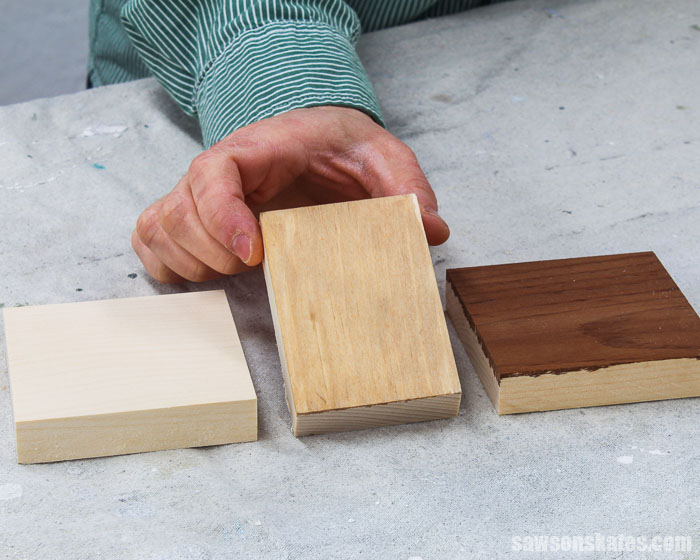
What Kind of Wood Can You Stain?
The vinegar steel wool stain can be used on any type of wood, but each wood will react differently. All of the samples in this tutorial were tested on pine.
And remember that the chemical reaction between the stain and wood can be slightly unpredictable. In other words, the color might vary slightly from board to board.
I would recommend trying the stain on some test pieces before using it on your project to be sure it will give you the color that you want.
Back to Table of ContentsHow Do You Apply the Steel Wool and Vinegar Stain?
I used a disposable brush to apply the stain. A foam brush or an inexpensive chip brush works well for this. I didn’t use my good quality brushes that I use to paint my projects because I was concerned the steel wool and vinegar mixture might permanently stain them.
Related: How to Clean Paint Brushes
💡 TIP: The vinegar steel wool mixture will stain hands, clothes, and surrounding surfaces. Be sure to wear disposable gloves, old clothes, and protect the surrounding area with a drop cloth.
Back to Table of ContentsHow Many Coats of Steel Wool and Vinegar Stain Can You Apply?
You could apply multiple coats of this stain, but my recommendation is to only apply one coat. In this sample, I applied one coat to the wood on the left and two coats to the wood on the right.
The grain of the wood with two coats nearly disappears. And it almost looks painted rather than stained. For those reasons, my recommendation is to only apply one coat.
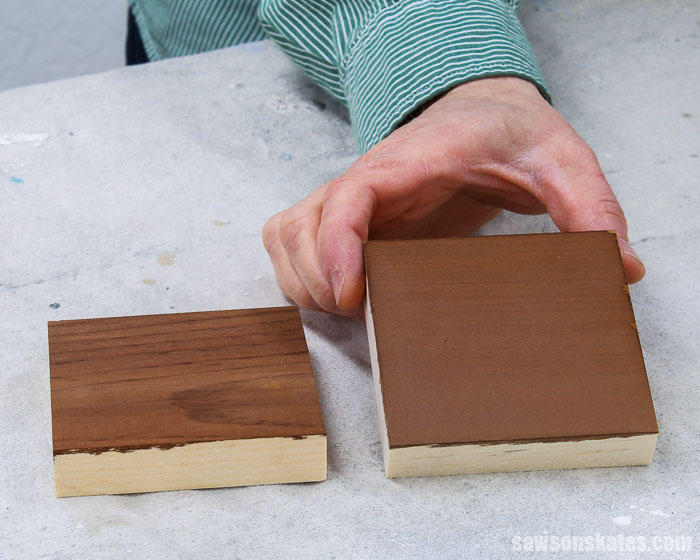
Do You Need to Sand Between Coats?
I did not sand between coats. But again, I would recommend applying only one coat.
Back to Table of ContentsHow Do You Prepare the Wood?
The wood should be smoothed before applying the stain. I sanded the samples in this tutorial with 100 grit and 120 grit sandpaper.
Related: 11 Secrets for Sanding Wood Projects Like a Pro
After the wood is smooth, you can apply the stain directly to the wood.
Or you can apply a homemade pre-stain conditioner before applying the stain. The conditioner will enhance the color of the of the stain.
I experimented with (tea, coffee, and black walnut stain) for this tutorial. I let the homemade conditioners dry completely before applying the steel wool stain. See the experiment results for the color options.
Back to Table of ContentsHow Do You Seal the Wood?
Applying this vinegar steel wool stain makes the surface of the wood almost feel like velvet. This means the surface of the wood is no longer smooth.
After the stain dried, I lightly sanded the wood with 220 grit sandpaper to smooth the surface. Then, I removed the sanding dust with a ShopVac.
It’s important to mention that water will remove some of the stain from the wood. For that reason, I wouldn’t recommend applying a water-based top coat directly to the stain.
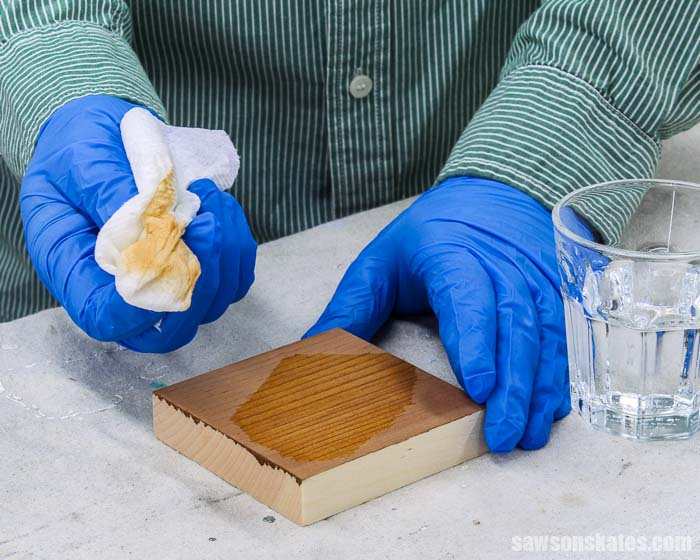
Instead, I would first seal the stain with a shellac-based sanding sealer. Then a water-based sealer like Polycrylic or this polyurethane alternative could be applied to the project.
Related: Polycrylic vs Polyurethane: Are They the Same?
An oil-based top coat, like an oil-based polyurethane, could be applied directly to the stain.
Related: How to Spray Polyurethane
Back to Table of ContentsHow Long Should You Wait Before Sealing?
I usually wait about 24 hours after applying any stain before I apply a finish.
Back to Table of ContentsSteel Wool and Vinegar Stain
Supplies
- #0000 Steel Wool
- Vinegar (White, Apple Cider, Red Wine, or Balsamic)
- Container (I used a 1-quart Mason Jar)
- Disposable Gloves
- Strainer (I used stockings)
- Disposable Brush (Foam Brush or Chip Brush)
- Drop Cloth
Step 1. Make the Stain
Place a steel wool pad in a 1-quart mason jar.
🔄 OPTIONAL: You can pull apart the pad to expose a larger surface area.
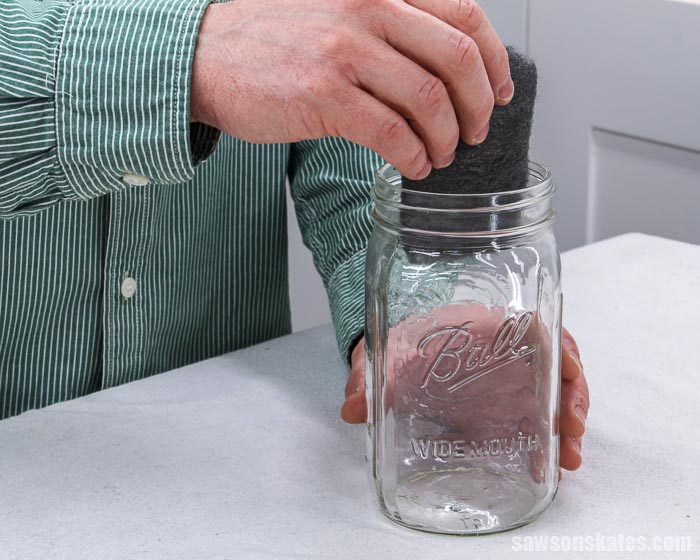
Pour about two cups of vinegar (white, apple cider, red or balsamic) over the steel wool.
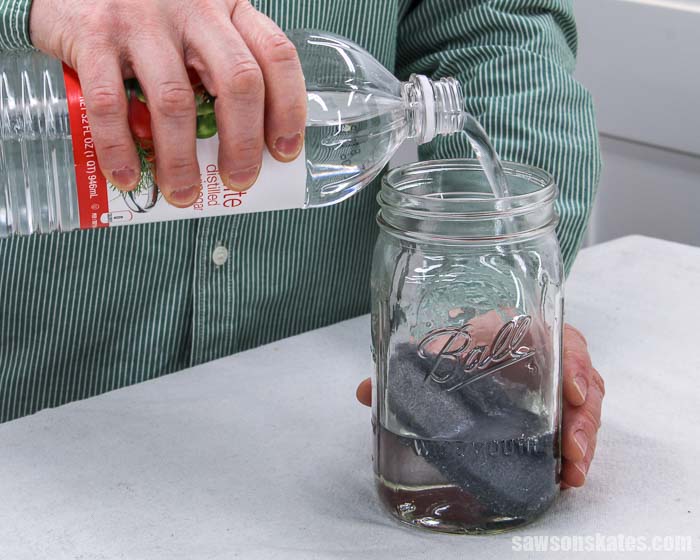
Allow the mixture to sit uncovered for about 24 hours or up to a few days. I let my mixture sit for about three to four days.
⚠️ IMPORTANT: Do not cover the container. The chemical reaction causes the steel wool and vinegar mixture to off-gas. This gas must be able to escape from the container. Allow the mixture to sit uncovered either outdoors or in a well-ventilated area.
After the mixture sat for three to four days, I strained it using one of the techniques that I use to strain paint.
Related: How to Strain Paint
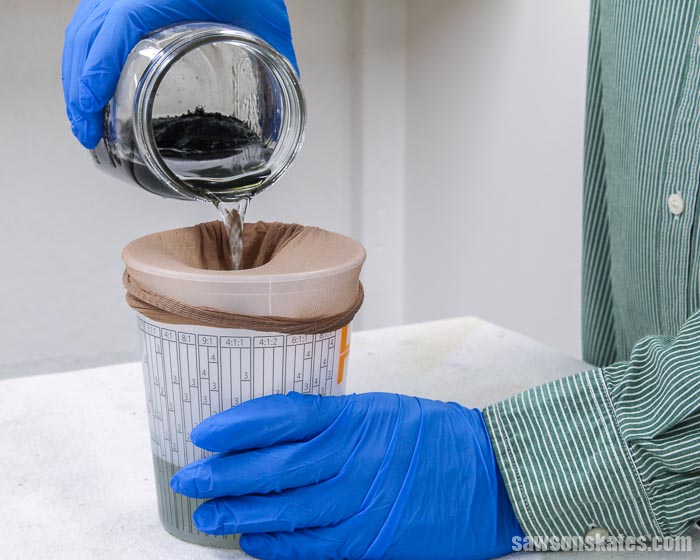
Step 2. Prepare the Wood
The wood should be smooth before applying the stain. I sanded the samples in this tutorial with 100 grit and 120 grit sandpaper.
Related: 11 Secrets for Sanding Wood Projects Like a Pro
🔄 OPTIONAL: Apply a DIY pre-stain conditioner to the wood before apply the stain.
I experimented with three homemade pre-stain conditioners (tea, coffee, and black walnut stain). I let them dry completely before applying the steel wool stain.
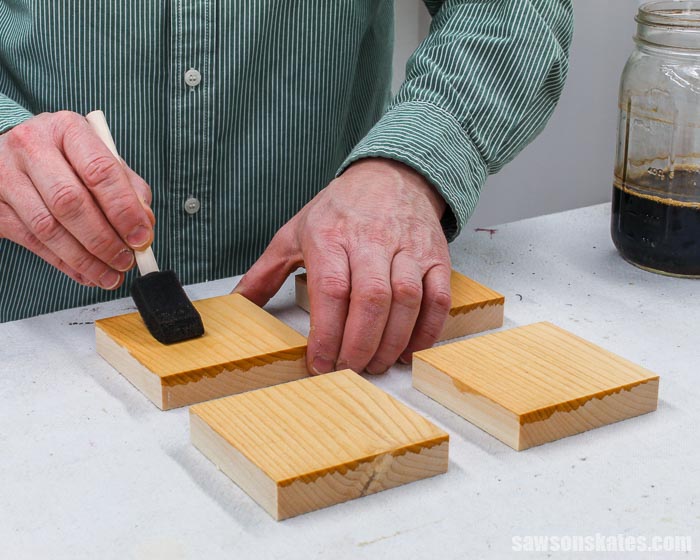
Step 3. Apply the Steel Wool and Vinegar Stain
I applied the stain with a foam brush. You could also use an inexpensive chip brush.
💡 TIP: The vinegar steel wool mixture will stain hands, clothes, and surrounding surfaces. Be sure to wear disposable gloves, old clothes, and protect the surrounding area with a drop cloth.
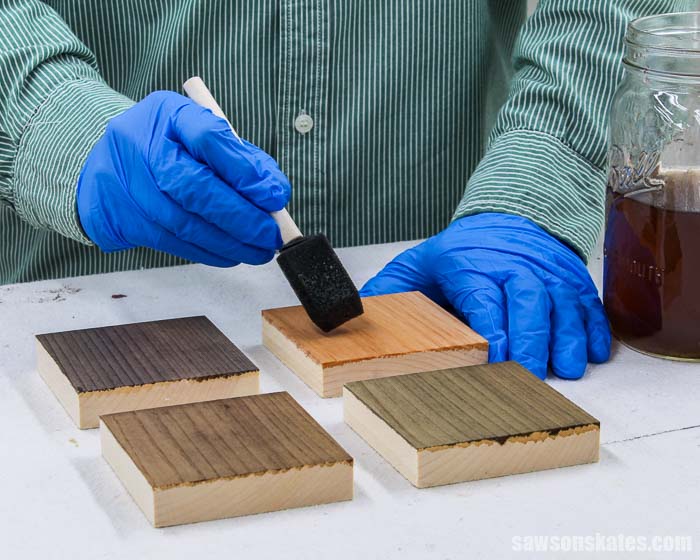
Step 4. Seal the Stain
See How Do You Seal the Wood? for more information.
Final Thoughts
This DIY stain is made with two simple ingredients. Steel wool and vinegar. Steel wool and vinegar stain is a great alternative to store-bought wood stains. It’s easy to make, easy to apply, and instantly darkens wood.
Thank you for stopping by. If you enjoyed this tutorial, would you please take a moment and pin it to Pinterest? I’d really appreciate it!

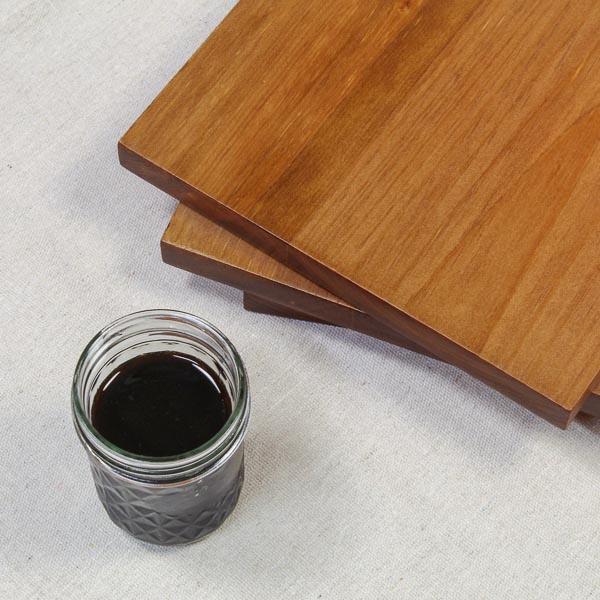
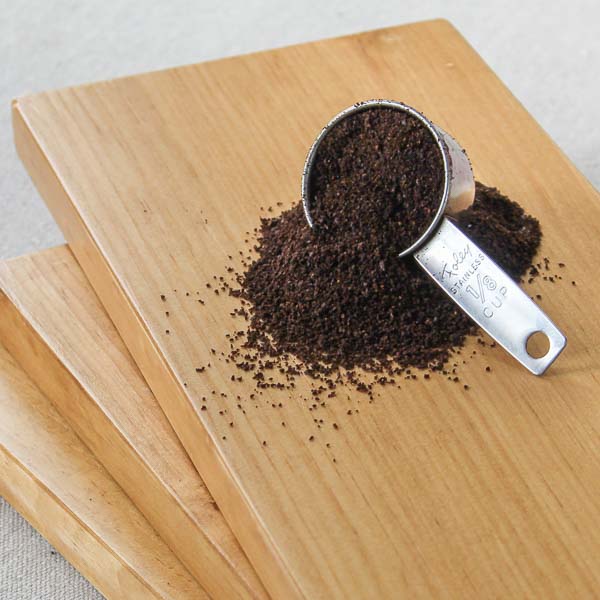
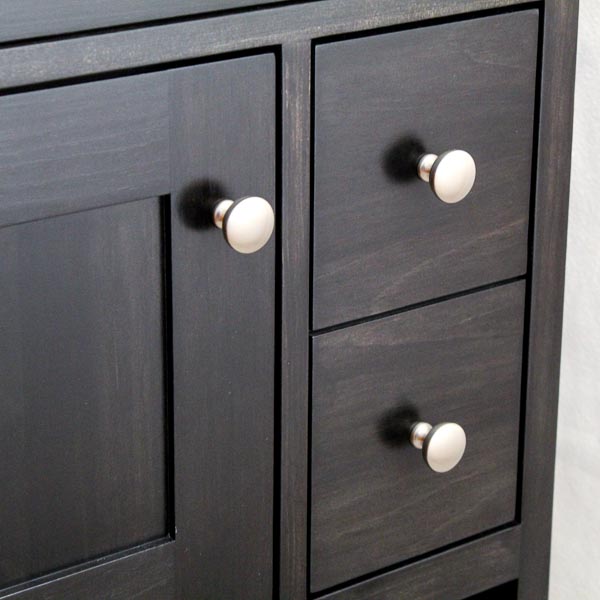

I “stained” a side table I made from 1×8 cedar this way.
I made a lot of test samples using white, apple cider and balsamic – with and without your black tea pre-stain. I ran out of balsamic but it was my favorite. As an ultimate act of laziness, I just went with white (after the black tea) rather than running to the store to get more.
It turned out a rather handsome medium brown. Quite the change from the natural cedar tone.
I wish I could upload images.